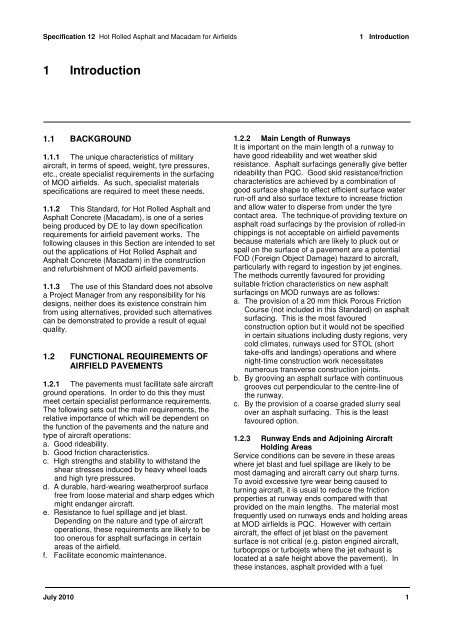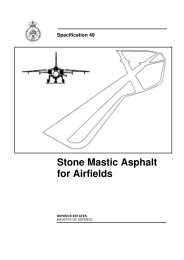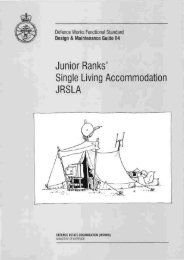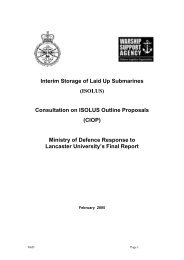Hot Rolled Asphalt and Asphalt Concrete (Macadam) - Ministry of ...
Hot Rolled Asphalt and Asphalt Concrete (Macadam) - Ministry of ...
Hot Rolled Asphalt and Asphalt Concrete (Macadam) - Ministry of ...
You also want an ePaper? Increase the reach of your titles
YUMPU automatically turns print PDFs into web optimized ePapers that Google loves.
Specification 12 <strong>Hot</strong> <strong>Rolled</strong> <strong>Asphalt</strong> <strong>and</strong> <strong>Macadam</strong> for Airfields 1 Introduction<br />
1 Introduction<br />
1.1 BACKGROUND<br />
1.1.1 The unique characteristics <strong>of</strong> military<br />
aircraft, in terms <strong>of</strong> speed, weight, tyre pressures,<br />
etc., create specialist requirements in the surfacing<br />
<strong>of</strong> MOD airfields. As such, specialist materials<br />
specifications are required to meet these needs.<br />
1.1.2 This St<strong>and</strong>ard, for <strong>Hot</strong> <strong>Rolled</strong> <strong>Asphalt</strong> <strong>and</strong><br />
<strong>Asphalt</strong> <strong>Concrete</strong> (<strong>Macadam</strong>), is one <strong>of</strong> a series<br />
being produced by DE to lay down specification<br />
requirements for airfield pavement works. The<br />
following clauses in this Section are intended to set<br />
out the applications <strong>of</strong> <strong>Hot</strong> <strong>Rolled</strong> <strong>Asphalt</strong> <strong>and</strong><br />
<strong>Asphalt</strong> <strong>Concrete</strong> (<strong>Macadam</strong>) in the construction<br />
<strong>and</strong> refurbishment <strong>of</strong> MOD airfield pavements.<br />
1.1.3 The use <strong>of</strong> this St<strong>and</strong>ard does not absolve<br />
a Project Manager from any responsibility for his<br />
designs, neither does its existence constrain him<br />
from using alternatives, provided such alternatives<br />
can be demonstrated to provide a result <strong>of</strong> equal<br />
quality.<br />
1.2 FUNCTIONAL REQUIREMENTS OF<br />
AIRFIELD PAVEMENTS<br />
1.2.1 The pavements must facilitate safe aircraft<br />
ground operations. In order to do this they must<br />
meet certain specialist performance requirements.<br />
The following sets out the main requirements, the<br />
relative importance <strong>of</strong> which will be dependent on<br />
the function <strong>of</strong> the pavements <strong>and</strong> the nature <strong>and</strong><br />
type <strong>of</strong> aircraft operations:<br />
a. Good rideability.<br />
b. Good friction characteristics.<br />
c. High strengths <strong>and</strong> stability to withst<strong>and</strong> the<br />
shear stresses induced by heavy wheel loads<br />
<strong>and</strong> high tyre pressures.<br />
d. A durable, hard-wearing weatherpro<strong>of</strong> surface<br />
free from loose material <strong>and</strong> sharp edges which<br />
might endanger aircraft.<br />
e. Resistance to fuel spillage <strong>and</strong> jet blast.<br />
Depending on the nature <strong>and</strong> type <strong>of</strong> aircraft<br />
operations, these requirements are likely to be<br />
too onerous for asphalt surfacings in certain<br />
areas <strong>of</strong> the airfield.<br />
f. Facilitate economic maintenance.<br />
1.2.2 Main Length <strong>of</strong> Runways<br />
It is important on the main length <strong>of</strong> a runway to<br />
have good rideability <strong>and</strong> wet weather skid<br />
resistance. <strong>Asphalt</strong> surfacings generally give better<br />
rideability than PQC. Good skid resistance/friction<br />
characteristics are achieved by a combination <strong>of</strong><br />
good surface shape to effect efficient surface water<br />
run-<strong>of</strong>f <strong>and</strong> also surface texture to increase friction<br />
<strong>and</strong> allow water to disperse from under the tyre<br />
contact area. The technique <strong>of</strong> providing texture on<br />
asphalt road surfacings by the provision <strong>of</strong> rolled-in<br />
chippings is not acceptable on airfield pavements<br />
because materials which are likely to pluck out or<br />
spall on the surface <strong>of</strong> a pavement are a potential<br />
FOD (Foreign Object Damage) hazard to aircraft,<br />
particularly with regard to ingestion by jet engines.<br />
The methods currently favoured for providing<br />
suitable friction characteristics on new asphalt<br />
surfacings on MOD runways are as follows:<br />
a. The provision <strong>of</strong> a 20 mm thick Porous Friction<br />
Course (not included in this St<strong>and</strong>ard) on asphalt<br />
surfacing. This is the most favoured<br />
construction option but it would not be specified<br />
in certain situations including dusty regions, very<br />
cold climates, runways used for STOL (short<br />
take-<strong>of</strong>fs <strong>and</strong> l<strong>and</strong>ings) operations <strong>and</strong> where<br />
night-time construction work necessitates<br />
numerous transverse construction joints.<br />
b. By grooving an asphalt surface with continuous<br />
grooves cut perpendicular to the centre-line <strong>of</strong><br />
the runway.<br />
c. By the provision <strong>of</strong> a coarse graded slurry seal<br />
over an asphalt surfacing. This is the least<br />
favoured option.<br />
1.2.3 Runway Ends <strong>and</strong> Adjoining Aircraft<br />
Holding Areas<br />
Service conditions can be severe in these areas<br />
where jet blast <strong>and</strong> fuel spillage are likely to be<br />
most damaging <strong>and</strong> aircraft carry out sharp turns.<br />
To avoid excessive tyre wear being caused to<br />
turning aircraft, it is usual to reduce the friction<br />
properties at runway ends compared with that<br />
provided on the main lengths. The material most<br />
frequently used on runways ends <strong>and</strong> holding areas<br />
at MOD airfields is PQC. However with certain<br />
aircraft, the effect <strong>of</strong> jet blast on the pavement<br />
surface is not critical (e.g. piston engined aircraft,<br />
turboprops or turbojets where the jet exhaust is<br />
located at a safe height above the pavement). In<br />
these instances, asphalt provided with a fuel<br />
July 2010 1









